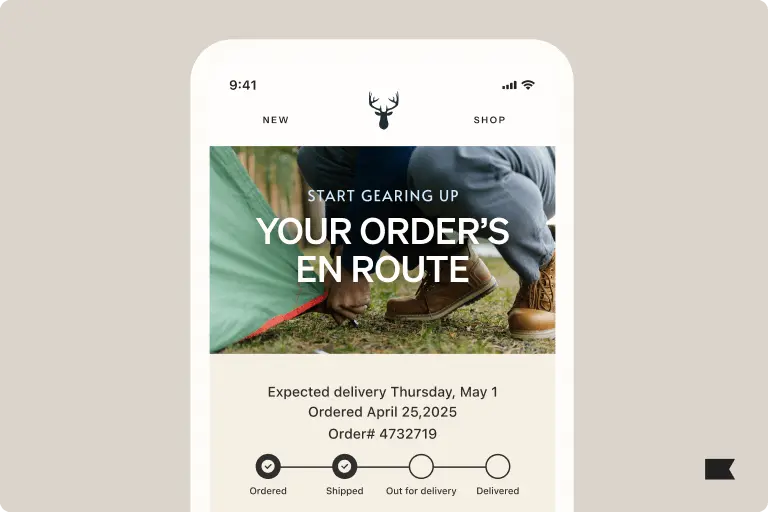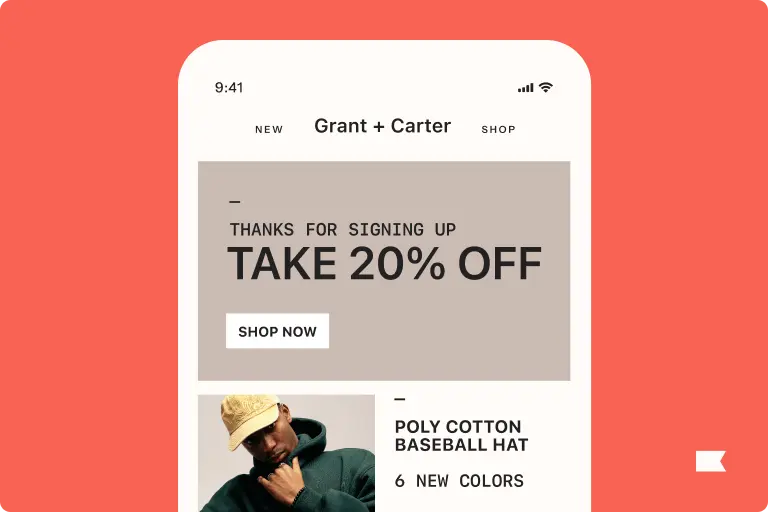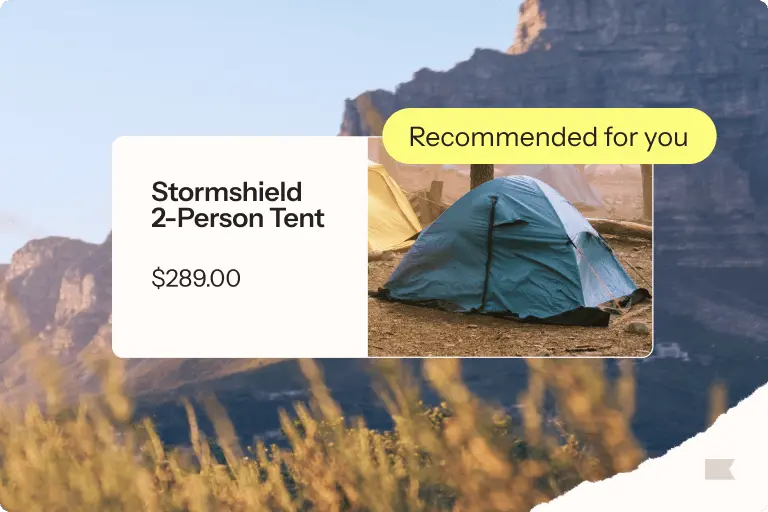Own your data, control your destiny: email marketing is the best revenue driver for small businesses
The data you own is the data you learn from.
For small businesses who are just starting to build close relationships with potential customers, owned marketing is a window to your audiences’ souls—what speaks to them, what fulfills their needs, and what journey they need to take before making a purchase.
Email marketing, a branch of owned marketing, persists as a preferred channel among small businesses because it aggregates data you can access and analyze and it works with little investment.
This matters now more than ever, as Apple’s data privacy changes wiped out much of the audience-targeting parameters that made paid social a viable option for small businesses.
Since then, cost per acquisition has soared, return on ad spend has plummeted, and granular third-party access to audience data remains as opaque as ever.
Cameron Faist, VP of growth at Aura Bora, has experienced this firsthand with his use of Klaviyo for email marketing.
Of course there’s a cost to Klaviyo, but nowhere near the tens of thousands of dollars Facebook and TikTok ads cost.
“Of course there’s a cost to Klaviyo, but nowhere near the tens of thousands of dollars Facebook and TikTok ads cost,” Faist says. “When we’re increasing our campaign sends, that revenue has no cost associated with it.”
“We look at Klaviyo as a no-cost channel,” Faist adds. “We absolutely saw a better P&L for our DTC side of the business as a result of this shift.”
This is why many small businesses continue to invest in email marketing to drive sales. According to Klaviyo’s marketing mix report, 76.86% of all businesses place email marketing in the top 3 ROI-generating marketing channels.
As the ancient marketing proverb goes, “The money is in the list.” Here’s where you learn how to start your email marketing initiative, how to get the most out of it, and where to focus your efforts so your small business can master email marketing as a channel.
Why is email marketing important for a small business?
You may already understand why email marketing is important for your small business, but that doesn’t mean your colleagues do. If you’re struggling to make the case for further investment in email as a channel, here’s some information you can draw from:
Email earns high returns for minimal investment
According to Litmus, email marketing earns $36 for every $1 spent. That number shoots up to $45 when you zero in on the retail, ecommerce, and consumer goods categories.
“Your most loyal Instagram follower is nothing compared to a subscriber,” says Ari Murray, VP of growth, Sharma Brands.
Your most loyal Instagram follower is nothing compared to a subscriber.
A follow on social media allows someone to interact with your brand passively, whereas subscribing to an email list indicates a higher level of intent. A subscriber may not be ready to buy, but they’re also less likely to pass over your messages than they would scrolling through a feed.
Email gathers and aggregates granular customer data
As a channel you own, email is a means to collecting the most amount of useful customer data possible. This type of data is called Customer-First Data™.
Customer-First Data is information the customer hands over voluntarily. Subscribers and customers provide their data through directly observable behavior like email engagement, post-email website activity, SMS engagement, and customer service interactions.
When your email software and customer data platform are one and the same, you can visualize data and answer questions like:
- Who has or hasn’t made a purchase?
- How long do they wait before ordering again?
- How much money are they spending, and when, and why?
- Who has a habit of buying only during gift-giving holidays?
- What makes someone unsubscribe?
- Are people more likely to open transactional emails, but more likely to click on promotional or educational ones?
- What makes someone bounce, and what makes them buy?
Email creates personalized communication and closer relationships
When you have enough Customer-First Data, you can start to segment your email list based on behavior and tailor your communication to people’s preferences. You may be able to do this in broad sweeps with paid search and paid social, but owned channels like email offer a level of granularity that’s unmatched by other channels.
Some examples of personalized email through segmentation are:
- Segmenting by geography: Send emails about local events or tailor messages according to regional trends and buying patterns.
- Segmenting by website activity: Send product-focused emails to people based on the pages they viewed on your website.
- Segmenting by purchase behavior: Send VIP offers or early access to new products to retain your most loyal customers.
Segmentation can also make sure you’re sending to someone every day, but without overwhelming your whole list. It’s what Little Sleepies leaned on for their Black Friday Cyber Monday strategy, by focusing more heavily on people who had just visited their website.
Klaviyo helped us target the correct people who were actually shopping.
“Sending every day was very important to us, but we also didn’t want to overwhelm,” says Christine Taylor, retention marketing manager at Little Sleepies. “So we really looked at how they were responding—have they been on the site within the last 24 hours? Klaviyo helped us target the correct people who were actually shopping.”
For more concrete examples of behavior-based targeting, skip ahead to learn about email automation flows.
How to build and run an email marketing campaign for a small business
Once you get the buy-in you need, you’ll face the best problem to have: figuring out where to start. We say it’s a good problem because it’s the dreamiest part of the process, when the work lies ahead and all you see on the horizon is possibility.
When you do roll up your sleeves, what are the first actions you should take? Here’s a step-by-step process that can guide you and save you some time:
Step 1: Choose the best email marketing software
Email marketing has come a long way throughout its 45-year history. Choose a tool that leverages the many advancements in email marketing best practices and technology that have emerged since it first started.
The best email marketing tools are not just email marketing tools. These tools are email builders at their most basic level, but they’re also:
- Customer data platforms
- Segmentation and list managers
- Sign-up form builders
- Email template repositories
- Email automation tools
- A/B testing deployers
- Analytics platforms
You should also expect your email marketing tool to come with loads of integrations that run well with your other ecommerce tools, like your online store, customer helpdesk, payment platform, loyalty program, etc.

Step 2: Create a sign-up form
“To grow and maintain an email list, what you must do, first, is have a pop-up,” says Connie Cen, founder and owner of Rocketeer Media.
“Yes, you really need it. 100%. 1,000%. Make sure you have that pop-up that asks customers to enter their email and their phone number. That’s one way you can really grow your email list.”
Pop-up forms can be controversial, but based on a recent analysis of Klaviyo sign-up forms, they convert at a higher rate (3.2%) than fly-out (2.2%) and embedded forms (1.04%).
Whether you choose to use pop-ups or not, you need to create some form of sign-up option on your website to collect email addresses as one of the first steps in your strategy.
Most email subscription forms use a discount incentive to encourage sign-ups. If that’s not in your budget, you have alternative options, but you can also factor in that people who view a sign-up form with a discount are 190% more likely to make an initial purchase than those who view a sign-up form without a discount.
Here are the main types of forms you’ll use to build your email list:
Embedded forms:
Embedded forms live on your website as a static form with an email address field and a sign-up button.
Pop-up forms:
A pop-up form doesn’t appear on your website until something triggers it, whether it’s scrolling down or hovering over a link. For example, an exit intent pop-up form appears when someone hovers over the address bar in their browser, signaling they’re about to leave your website.
Exit intent pop-ups:
These stand between where your website visitor is on your website and where they want to go, so they need to be eye-catching to make someone stop and enter their email address. This example from Olipop uses a bright pink background, an enticing product shot, and a 10% discount on first purchase—if any exit intent pop-up is going to convert, it’s this one.
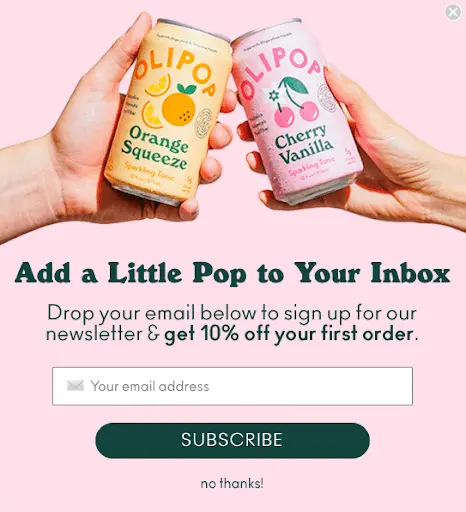
Multi-step forms:
If you want to collect more data about your potential customers but don’t want to intimidate people with a large, clunky form, you can use a multi-step form.
You can be clever about how you build multi-step forms, too. For example, Andi Swim uses a quiz to get more information on subscriber preferences, such as whether they like two-piece bathing suits or one pieces, high- or low-cut bottoms, etc. After gathering the data, the brand is able to send emails based on the types of products each audience segment is most likely to buy. AirPlunge, a cold plunge producer, likes to use quizzes to understand customer desires, which it uses to create marketing and video content for its social media platforms.
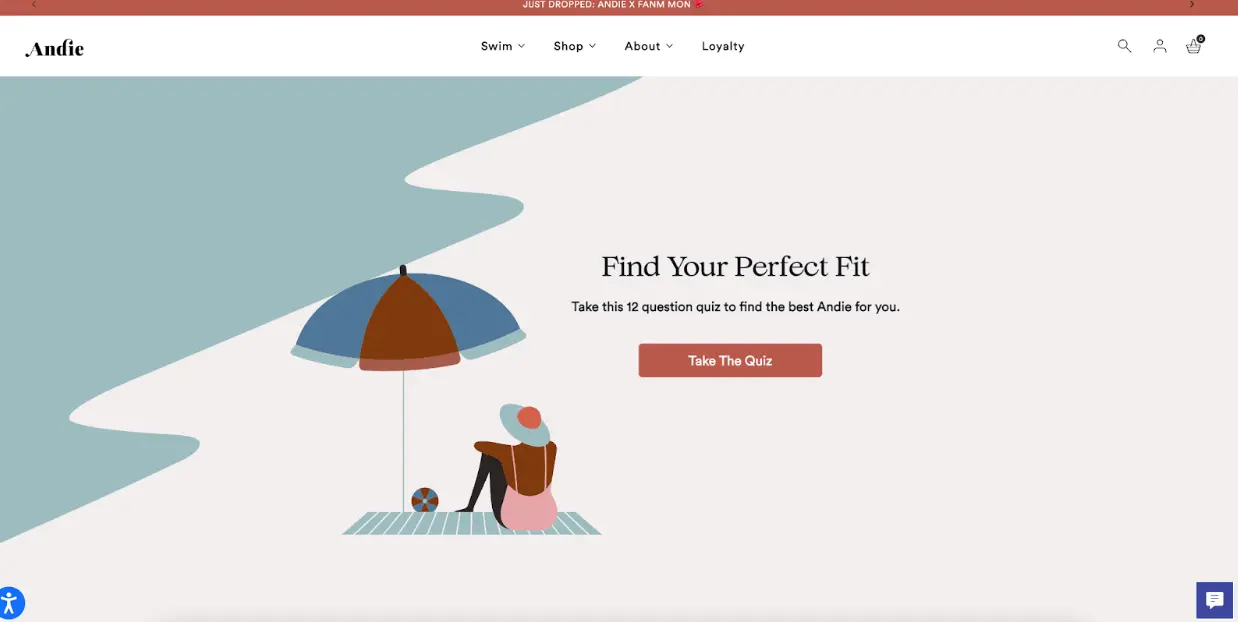
Step 3: Segment your subscriber list
“You have so much customer information at your fingertips, and so many merchants are skipping out on an opportunity to do something meaningful with that,” says Jen Brennan, director of digital marketing at Northern. “They take a very broad paintbrush to segmentation, and there are better ways to do it.”
So many brands are skipping out on the opportunity to do something meaningful with their customer information.
Whereas brands used to blast their entire email list with the same messages, today’s most effective email strategies use audience segmentation as a default. The best marketing teams segment their lists based on behavioral triggers—for example:
- Website visitors: getting down to the product description page level
- Campaign engagers: people who open and click on certain emails over others
- Buyers: to increase average spend and repeat purchases
- App activity: to engage with your “stickiest” users
Brennan understands why some brands may be hesitant to segment their lists. “People hear ‘segmentation’ and they hear, ‘I’m going to send this to fewer people,’” she acknowledges. “And yes, that may be true, but you’re sending to the right people who are going to give you greater overall results.”
If you consistently send relevant emails, your customers are more likely to trust your brand—and that’s “where you pivot into more of the retention and customer lifetime value conversation,” Brennan points out.
Step 4: Clarify your value propositions
Benefits, differentiators, value propositions—these are all words for “the reason people buy from one brand over another.”
Your value proposition is the primary benefit your new customers enjoy when they’ve purchased one of your products. It’s the short and snappy answer to, “What’s in it for me?”—and it’s important to do the work to define what those things are before you send your first email.
Your value propositions may evolve as you discover more about your audience, and that’s okay. But it’s important to develop a working theory about what makes your brand special as you’re launching your email strategy, if only so you have a place to start when you’re staring at a blank screen.
If you’re hazy on what a value proposition looks like in action, check out this example from Filson.

With a bold headline and the perfect image to complement it, Filson doubles down on credibility as their primary benefit.
And Filson’s email copy—“We’ve been doing this for more than 100 years”—is a bet that other brands in their category can’t say the same thing, making the email an effective attempt at capturing attention.
Step 5: Design with conversions in mind
First: “Good design” is subjective. What works for one brand may not work for yours.
While you’ll need to A/B test various elements of your email design to find out what works, Cen advises brands to look to their category for some overarching conventions.
For example, “if you’re more of a fashion lifestyle brand,” she says, “shorter copywriting with tons of images works really well. If you’re a health brand selling supplements, more informational, long-form content tends to work better, because customers want to know how this will benefit them.”
Regardless, basic email templates look something like this:
- Heading
- Hero image
- A short blurb
- Call-to-action (CTA) button
You may want to deviate from this template because you want to include more product shots, or you want to test a CTA button near the top. Your options are plentiful, but we recommend adhering to some basic principles:
- Include your logo.
- Include your social media links.
- Include an unsubscribe link at the bottom—it’s the law.
- Use images, but don’t stuff your email with so many that it can’t load quickly.
- Experiment with colorful or patterned backgrounds.
- Don’t include more than 3 CTAs.
- Always optimize for mobile devices—odds are, this is how people will view your email.
“If you want more revenue from your emails,” Cen says, include at least 3 things above the fold: the headline, an image, and the CTA.
Captivate your audience before that first scroll. Because believe it or not, I guarantee that 80% of people do not scroll past the first part of the email.
This way, “right when someone opens their email, they see everything in that first part—before they even scroll,” Cen explains. “That’s your goal. Captivate your audience before that first scroll. Because believe it or not, I guarantee that 80% of people do not scroll past the first part of the email.”
Outdoorplay integrates copy, image, and CTA beautifully in this example.

All above the fold, each element works together to create a shortcut for people who are ready to buy. Assuming Outdoorplay has segmented their list properly and nurtured their audience for this particular email before sending, the “Shop Tents” CTA is perfectly positioned for people who don’t need to scroll further to make a purchase decision.
How to set up email automations, or flows
Email campaigns are important—they earn an average 58.61% open rate across all industries, according to Klaviyo’s latest email marketing benchmarks. But email automations are what can drive revenue while you sleep.
Ezra Firestone, CEO of Boom by Cindy Joseph and founder of Smart Marketer and Zipify Apps, says email marketing automations are an opportunity to get creative—and incredibly granular—with Customer-First Data™.
“What we do is we collect individualized data points on people—‘What month were you born? What kind of dog do you have? What color hair do you have?’” Firestone explains. “Then we trigger automations based on the data points that we collected.”
If that seems overwhelming and you need a place to start, here are some fundamental automations to play with first:
Welcome email
A welcome email series is a sequence of automated emails that go out to new subscribers after they sign up to join your list. It’s the first time people hear from you.
We’ve found that most people make a purchase within 10 days of subscribing to a mailing list.
Why are welcome emails important? “We’ve found that most people make a purchase within 10 days of subscribing to a mailing list,” says Alexa Engelhart, vice president of client strategy at Power Digital Marketing. “Make sure you have emails sending throughout that 10-day window when people are most likely to purchase.”
How do welcome emails perform? According to Klaviyo benchmarks, welcome emails earn, on average, a 55.61% open rate, a 6.62% click rate, and a 2.38% conversion rate.
What does a welcome email look like? Welcome emails generally fall into 4 categories:
- Educational
- Offer
- Product focus
- Data gathering
These categories may overlap depending on your goals. For example, Brightland’s welcome email is divided into sections that educate their audience on the ingredients that make each product stand out.

Browse abandonment email
Browse abandonment emails are messages that go out automatically after a subscriber browses your website and leaves without placing an item in their shopping cart.
When you send a browse abandonment email, you’re nudging people to take a second look at the product on your website. Think of it as your second chance to encourage someone to buy, whether it’s through:
- Showing more benefits
- Comparing your product to a competitor
- Highlighting a customer testimonial
- Sending a special offer
Why are browse abandonment emails important? Browse abandonment emails intervene at a crucial point in the customer journey: product comparison and price shopping. They’re one of the most effective ways to convert shoppers who have displayed interest in a certain product.
How do browse abandonment emails perform? According to Klaviyo data, browse abandonment emails have a 0.96% conversion rate—9.6x higher than the average email campaign.
What does a browse abandonment email look like? Browse abandonment emails usually target 4 audience segments:
- Shoppers who have never purchased
- One-time purchasers who are showing interest again
- Loyal customers who usually buy
- Shoppers who have never purchased but are showing interest in the same product over and over again
Segments of people who have never purchased will likely need more education before they buy. This example from Neptune demonstrates what this can look like for your brand, with copy chock-full of features and benefits to help browse abandoners with the decision-making process.

And how to incite people to open your emails? By writing captivating browse abandonment subject lines.
Cart abandonment email
An abandoned cart email re-engages shoppers who add products to their online cart but leave the site without purchasing them.
Why are abandoned cart emails important? 70% of online shopping carts are abandoned, according to a study by the Baymard Institute. If you’re not sending abandoned cart emails that educate people and nudge them to buy, you’re leaving a lot of money on the table.
How do abandoned cart emails perform? According to Klaviyo data, average recovery rates correspond with average order value (AOV)—the higher the AOV, the higher the recovery rate. But only up to a point: Recovery rates also correspond with number of orders per month, with higher recovery rates for a higher number of orders.
For example, in a 2022 analysis of Klaviyo users, recovery rates for AOVs from $1-49 were just over 3%, but they increased to 5.87% when there were 1K+ orders per month. For purchases between $100-499, average recovery rates for 1-99 orders per month rose to 4.38%. But with AOVs of $500 or more, that’s when recovery rates began to drop off a little.
It’s also worth noting, however, that the top 10% of Klaviyo customers had high recovery rates—all above 6% and some close to 10%—no matter their order sizes or AOVs.
What does an abandoned cart email look like? According to Morgan Mulloy, director of retention marketing at Avex Designs, the best abandoned cart emails highlight customer support options. Mulloy says abandoned cart emails are “a great place to list out return policies, shipping estimates, and channels for assistance.”
Neal Ashton, Chief Marketing Officer of JugJacket agrees – “try to address common reasons you’ve found that are preventing a customer from making a purchase, and address them specifically.”
Only Curls exemplifies a customer support strategy with their cart abandonment email, and it works because it’s more like an email you would get from a personal contact than a brand.

Order confirmation email
Order confirmation emails confirm the details of a customer’s purchase, including the order number, the products they purchased, billing information, and shipping details.
Why are order confirmation emails important? Order confirmation emails establish trust. They acknowledge the purchase is complete and set clear expectations about shipping and receipt. They also create excitement and reinforce the decision to buy.
How do order confirmation emails perform? Order confirmation emails are one type of transactional email, which have high open rates because they contain essential information. They’re also a type of post-purchase email, which, according to the latest quarterly Klaviyo email benchmarks, earn the highest average open rates of any email automation at 61.05%.
What does an order confirmation email look like? Some order confirmation emails are bare bones—and if most of your customers are in Europe, they need to be so they comply with GDPR. But in the US, they can also be an opportunity to nurture customers beyond a sale.
Sometimes this looks like educational content or user-generated content (UGC) that acts as social proof to reaffirm the decision to buy, but it’s possible to build good relationships on simpler terms. A great example is this order confirmation email from Wildfang.
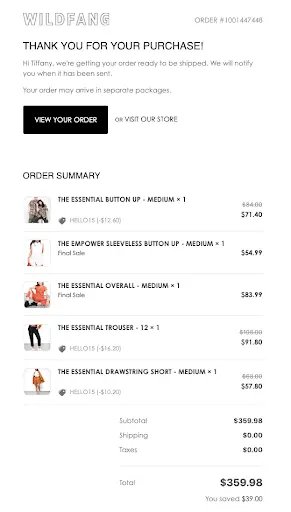
The email is a masterclass in subtlety, in that it sets expectations while creating some hype around savings. Wildfang itemizes each piece of clothing and says everything is ready to be shipped—while setting the expectation that items may arrive in separate packages.
The customer can also see which items are final sale and which items they saved money on with a discount code. The total amount of savings is the last little piece of flair that makes the customer feel good about their purchase.
Shipping confirmation email
Shipping confirmation emails keep the customer informed about shipping timelines and include tracking information to help the customer monitor the progress of their package.
Why are shipping confirmation emails important? Shipping confirmation emails are just good customer service. They’re also what prevent customers from calling your customer service reps to clarify the details of their order, especially if it’s late. Where there’s confusion there will always be attempts at clarity, and shipping confirmations and delay notifications can fill that gap.
What does an order confirmation email look like? Shipping confirmation emails contain 3 main elements:
- A clear statement that the customer’s order is on the way
- An estimated timeline for when the order is expected to arrive
- A tracking link the customer can use to check on the status of their order
This example from OSEA displays all 3 of those elements. The box at the top of the email is a nice design touch, too, as it makes it easy for recipients to track their package.
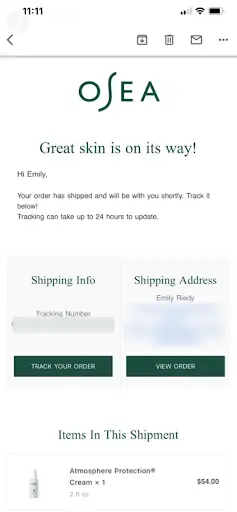
How to monitor your email marketing efforts
You can master email segmentation, copy, and design, but you’ll never master email marketing without learning how to monitor and optimize your emails based on specific goals.
Especially as a small business with a lot of pending questions about your audience, you may not yet know exactly what works—which means you’ll need to lean heavily on A/B testing and data analysis to keep incrementally improving your strategy.
So much of this process involves following your own intuition as an entrepreneur, then gut checking that intuition against hard data—so consider this section a kickstart to figuring out what works for your brand.
A/B test subject lines, images, CTAs, and copy—but not all at the same time
Cen promotes constant A/B testing with her clients to keep up with ever-evolving customer preferences.
“You need to continue optimizing your flows every single month,” Cen says. “Your customer demographic, believe it or not, changes every single month. Your products change every single month. It’s important to really keep those automations in line every single month.”
Some basic examples of A/B tests for email are:
- Testing subject lines for open rate performance
- Testing CTAs for click rate performance
- Testing images and layouts for click rate performance
The golden rule of A/B testing is to test only one element at a time. If you’re testing subject lines, don’t test CTAs at the same time—the double variable will skew your results, and you won’t know what’s responsible for an improvement or drop in performance.
With Klaviyo, you can customize your A/B test parameters by audience percentage and time.
For example, you can choose to reserve 20% of your email recipients for variation A, and another 20% for variation B. Depending on how many of your recipients click on the email, a winner emerges after 6 hours—and the rest of the recipients automatically receive the winning variation.

Analyze key email marketing metrics—but customize your analysis to your goals
The way successful brands report on email marketing metrics has changed a lot in the last 2 years.
Apple’s iOS 15 privacy features, launched in June 2021, allow Apple Mail users to block third parties from tracking email opens. With 65% of email client market share owned by Apple, that means a significant portion of your brand’s open rate metrics don’t reflect how many people actually opened your email.
But that doesn’t mean open rates are now considered a vanity metric across the board.
Ananda Farge, email marketing associate director at The Stable, says she still values open rate—but only relative to itself and other metrics that inform her about the overall health of an email program.
“I’m straightforward with clients about the new limitations of iOS 15,” she says. “We know that a 60% open rate doesn’t mean 60% of people actually opened your email. But if we had a 60% open rate on Monday, and on Tuesday we see a 40% open rate, we can compare campaigns and make decisions from there. Maybe deliverability dropped off, so we’ll look at that.”
[Email marketing metrics] are only meaningful when you analyze them relative to each and within the context of a specific goal.
Farge highlights one of the most fundamental lessons a marketer can learn about email marketing metrics: They’re only meaningful when you analyze them relative to each other and within the context of a specific goal.
If you’re focused on sales, for example, Firestone advises focusing on how much money emails are generating.
“What will tell you ultimately how valuable a piece of content is, is how many people are coming from this piece of content and landing on the product page, and then what’s the revenue per visit from that traffic source?” he points out.
If you’re focused on retention, meanwhile, Bonnie Pecevich, director of product marketing at Pantastic, recommends zeroing in on repeat purchase rate.
“Repeat purchase rate tells you how well you’re engaging and converting your existing customers and compelling them to buy from you again,” she explains.
Regardless of goals, important email metrics to monitor include:
The percentage of recipients who click on a link in an email.
Website activity after a recipient clicks on an email, such as how much time they spend on your website, which product pages or landing pages they browse, and what they leave in their carts.
The percentage of recipients who take action after they click on an email.
The total amount of revenue your email generates divided by total email deliveries.
The percentage of emails that makes it to your recipients’ inboxes.
The percentage of people who receive your email and then unsubscribe from your list.
Depending on your goals, you may take stock of your email marketing metrics on a monthly or quarterly basis. Murray opts for a big-picture view on a quarterly basis to evaluate longer-term trends.
“We’re really focused on a 90-day look-back where we’re analyzing what happened, whether anything changed for the worse, what we did that was different, what’s happening in the macroeconomic climate, what are we seeing other brands do that we don’t like,” Murray explains.
Email marketing for small businesses doesn’t need to be difficult
We’ve given you a place to start with email marketing for your small business, but as you learn more about what your audience wants, you’ll be the one to make your email marketing shine.
“Keeping it simple will be a benefit when first starting out,” says Cassie Benjamin, email and SMS channel manager at Tadpull. “As you get your feet wet, you can begin to build out your flows to better personalize your messaging and strategy based on customer attributes and behavior.”
Email marketing for small business FAQs
Should small businesses invest in email marketing?
Yes, small businesses should invest in email marketing. According to Litmus, email marketing earns $36 for every $1 spent, so it’s a cost-effective way to reach and engage with audiences, build customer relationships, and drive sales. Email marketing also allows small businesses to collect valuable customer data they can own and analyze, which leads to personalized communication at scale.
How do you grow a small business with email marketing?
To grow a small business with email marketing, build a quality list of subscribers and segment your audience based on demographics, psychographics, and online behavior. Create valuable and relevant content that addresses the needs, interests, and behavior of each audience segment. Regularly analyze and optimize your click rates and conversion rates to improve your strategy and ultimately bring in more revenue.
What is the best email marketing strategy for small businesses?
The best email marketing strategy for small businesses will depend on product category, but some consistent principles include a focus on audience segmentation, personalized content, and maintaining a consistent schedule that prioritizes email deliverability and doesn’t overwhelm subscribers. Small businesses must also monitor and analyze metrics to refine their strategy over time, so they’re always adapting to subscriber and customer preferences.

